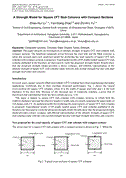p.402
p.406
p.416
p.421
p.425
p.431
p.437
p.443
p.450
A Strength Model for Square CFT Stub Columns with Compact Sections
Abstract:
This paper presents an investigation of ultimate strength of square CFT stub columns with compact sections. The beneficial composite action between the steel tube and the filled concrete is taken into account and a new analytical model for predicting the axial capacity of square CFT stub columns with compact sections is proposed. Experimental results of 89 axially loaded square CFT stub columns published in the literature are then used to verify the proposed strength model. Results show that the proposed strength model provides a direct, compact, and efficient representation of the ultimate strength of square CFT stub columns made with not only normal strength but also with high strength steel tubes and concrete.
Info:
Periodical:
Pages:
425-430
Citation:
Online since:
September 2011
Authors:
Keywords:
Price:
Permissions:
Сopyright:
© 2011 Trans Tech Publications Ltd. All Rights Reserved
Share:
Citation:

